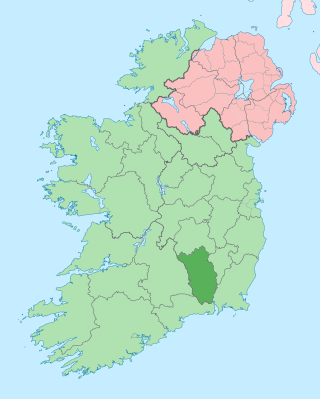
County Kilkenny is a county in Ireland. It is in the province of Leinster and is part of the Southern Region. It is named after the city of Kilkenny. Kilkenny County Council is the local authority for the county. At the 2022 census the population of the county was 103,685. The county was based on the historic Gaelic kingdom of Ossory (Osraighe), which was coterminous with the Diocese of Ossory.
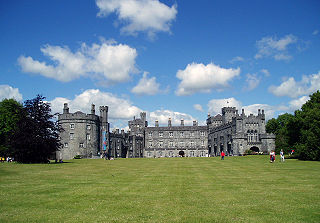
Kilkenny Castle is a castle in Kilkenny, Ireland, built in 1260 to control a fording-point of the River Nore and the junction of several routeways. It was a symbol of Norman occupation, and in its original 13th-century condition, it would have formed an important element of the town's defences with four large circular corner towers and a massive ditch, part of which can still be seen today on the Parade.

James Wyatt was an English architect, a rival of Robert Adam in the neoclassical and neo-Gothic styles. He was elected to the Royal Academy of Arts in 1785 and was its president from 1805 to 1806.
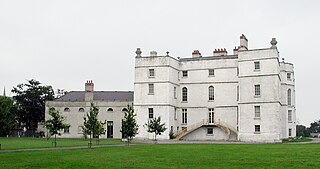
Rathfarnham Castle is a 16th-century fortified house in Rathfarnham, South Dublin, Ireland. Originally a semi-fortified and battlemented structure it underwent extensive alterations in the 18th century. It is in State care, has been restored and is open to the public.

Jenkinstown Park is a park in County Kilkenny, Ireland. It is situated off the N78 road about 10 km north of the city of Kilkenny and 11 km south of Castlecomer.
The architecture of Ireland is one of the most visible features in the Irish countryside – with remains from all eras since the Stone Age abounding. Ireland is famous for its ruined and intact Norman and Anglo-Irish castles, small whitewashed thatched cottages and Georgian urban buildings. What are unaccountably somewhat less famous are the still complete Palladian and Rococo country houses which can be favourably compared to anything similar in northern Europe, and the country's many Gothic and neo-Gothic cathedrals and buildings.

Foulksrath Castle is a 14th-century Anglo-Norman tower house located in Jenkinstown in County Kilkenny, Ireland.
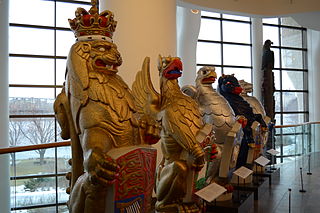
The Queen's Beasts are ten heraldic statues representing the genealogy of Queen Elizabeth II, depicted as the Royal supporters of England. They stood in front of the temporary western annexe to Westminster Abbey for the Queen's coronation in 1953. Each of the Queen's Beasts consists of a heraldic beast supporting a shield bearing a badge or arms of a family associated with the ancestry of Queen Elizabeth II. They were commissioned by the British Ministry of Works from the sculptor James Woodford, who was paid the sum of £2,750 for the work. They were uncoloured except for their shields at the coronation. They are now on display in the Canadian Museum of History in Gatineau, Quebec.
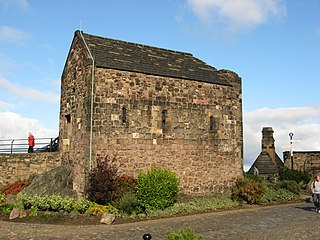
St Margaret's Chapel, in Edinburgh Castle, is the oldest surviving building in Edinburgh, Scotland. An example of Romanesque architecture, it is a category A listed building. It was constructed in the 12th century, but fell into disuse after the Reformation. In the 19th century the chapel was restored and today is cared for by the St Margaret's Chapel Guild.
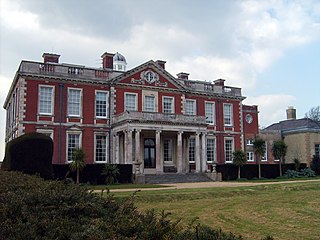
Stansted Park is an Edwardian country house in the parish of Stoughton, West Sussex, England. It is near the city of Chichester, and also the village of Rowlands Castle to the west over the border in Hampshire.

Emo Court, located near the village of Emo in County Laois, Ireland, is a large neo-classical mansion. Architectural features of the building include sash-style windows, pavilions, a balustrade, a hipped roof, and large dome.

Mount Loftus is a country estate in the civil parish of Powerstown in County Kilkenny, Ireland. It was originally home to the Loftus baronets, the baronetcy being extinct since the death of the third baronet in 1864. The original 18th century manor house was demolished in 1906. The current house on the estate, built in the early 20th century, was rebuilt from staff accommodations after a fire in the 1930s. This house, and several of its outbuildings, are included on Kilkenny County Council's Record of Protected Structures.

Hope Castle is a historic house and demesne in Castleblayney, County Monaghan, Ireland. Originally a private home, over the course of the 20th century, Hope Castle was used as a military barracks, a hospital, convent, and was most recently used as a hotel before it was damaged by a fire in 2010.

Elaine Carlisle Bellew-Bryan, Baroness Bellew, served in the First World War as a nurse and was one of the first women to be a member of the corporation in Kilkenny, from 1955 until 1973.

Butler House is an 18th-century Georgian Dower house located in Kilkenny, Ireland. It is currently working as a 4-star hotel and conference centre.
Dunleckney Manor is a manor house in Bagenalstown, County Carlow, Ireland.
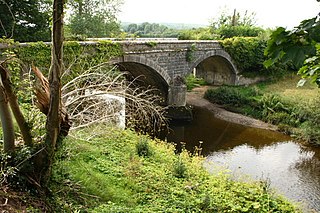
The River Dinan, Deen or Dinin is a river in Ireland, flowing through County Kilkenny and County Laois.

Clomantagh Castle is a 15th-century tower house located near Freshford, County Kilkenny, in Ireland. Originally constructed in the 1430s, additional buildings and outbuildings were added in the subsequent centuries - including a connected 19th century farmhouse. Carvings on the castle's walls include a Sheela na gig relief.

William Robertson, an Irish architect, was born in Kilkenny, Ireland, some days before 4 December 1770. He attended the Dublin Society where he was awarded with a silver medal for his drawing skills in 1795.

















